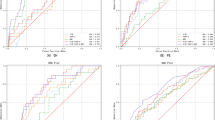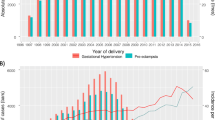Abstract
Objective
We aimed to develop a simple clinically useful prediction rule for early-onset recurrent preeclampsia and/or HELLP syndrome.
Methods
Women with previous early-onset preeclampsia and/or HELLP, enrolled between 1996 and 2007, and a subsequent ongoing pregnancy were included. Prepregnant cardiovascular, metabolic, renal, and clotting parameters were evaluated as potential predictors for recurrent disease by logistic regression analysis.
Results
Early-onset preeclampsia and/or HELLP recurred in 16 (9%) of 186 next pregnancies. The prediction model included high-density lipoprotein (mmol/L) and 24-hour urinary total protein excretion (mg/mmol creatinine). The receiver operating characteristic area was 0.77 (95% confidence interval: 0.68–0.87). Predictive sensitivity and specificity were 94% (69%–99%) and 53% (45%–60%), respectively. Nearly 50% of the women could be classified as having < 1% risk of recurrent early-onset disease.
Conclusions
The prediction rule identified, with clinically relevant predictive capacity, those women at very low risk for recurrent early-onset disease.
Similar content being viewed by others
References
Sibai B, Dekker G, Kupferminc M. Pre-eclampsia. Lancet. 2005;365:785–799.
Sibai BM. Diagnosis, prevention, and management of eclampsia. Obstet Gynecol. 2005;105:402–410.
Conde-Agudelo A, Villar J, Lindheimer M. World Health Organization systematic review of screening tests for preeclampsia. Obstet Gynecol. 2004;104:1367–1391.
van Pampus MG, Aarnoudse JG. Long-term outcomes after preeclampsia. Clin Obstet Gynecol. 2005;48:489–494.
Brown MA, Lindheimer MD, de Swiet M, Van Assche A, Moutquin JM. The classification and diagnosis of the hypertensive disorders of pregnancy: statement from the International Society for the Study of Hypertension in Pregnancy (ISSHP). Hypertens Pregnancy. 2001;20:9–14.
Sibai BM, Ramadan MK, Usta I, Salama M, Mercer BM, Friedman SA. Maternal morbidity and mortality in 442 pregnancies with hemolysis, elevated liver enzymes, and low platelets (HELLP syndrome). Am J Obstet Gynecol. 1993;169: 1000–1006.
The Netherlands Perinatal Registry [homepage on the internet]. Bilthoven: NPR-foundation. Available at: http://www.perinatreg.nl/. Accessed September 18, 2007.
Refsum H, Smith AD, Ueland PM, et al. Facts and recommendations about total homocysteine determinations: an expert opinion. Clin Chem. 2004;50:3–32.
Chronic hypertension in pregnancy. ACOG Committee on Practice Bulletins. Obstet Gynecol. 2001;98(1):suppl 177–85.
Longford N. Single Imputation and Related Methods. In: Missing Data and Small-area Estimation. London: Springer; 2005.
Glas AS, Lijmer JG, Prins MH, Bonsel GJ, Bossuyt PMM. The diagnostic odds ratio: a single indicator of test performance. J Clin Epidemiol. 2003;56:1129–1135.
Steyerberg EW, Harrell FE, Borsboom GJJM, Eijkemans MJC, Vergouwe Y, Habbema JDF. Internal validation of predictive models: efficiency of some procedures for logistic regression analysis. J Clin Epidemiol. 2001;54:774–781.
Witlin AG, Saade GR, Mattar F, Sibai BM. Predictors of neonatal outcome in women with severe preeclampsia or eclampsia between 24 and 33 weeks’ gestation. Am J Obstet Gynecol. 2000;182:607–611.
van Rijn BB, Hoeks LB, Bots ML, Franx A, Bruinse HW. Outcomes of subsequent pregnancy after first pregnancy with early-onset preeclampsia. Am J Obstet Gynecol. 2006;195:723–728.
Sibai BM, Ramadan MK, Chri RS, Friedman SA. Pregnancies complicated by HELLP syndrome (hemolysis, elevated liver enzymes, and low platelets): Subsequent pregnancy outcome and long-term prognosis. Am J Obstet Gynecol. 1995;172(Part 1): 125–129.
Morris J, Fay R, Ellwood D. Abnormal uterine artery waveforms in the second trimester are associated with adverse pregnancy outcome in high risk women. J Matern Fetal Investig. 1998;8:82–84.
Frusca T, Soregaroli M, Danti L, et al. Uterine artery velocimetry as a screening test in patients with previous preeclampsia. Ital J Gynaecol Obstet. 1996;8:94–98.
Mello G, Parretti E, Cioni R, Lagozio C, Mealli F, Pratesi M. Individual longitudinal patterns in biochemical and hematological markers for the early prediction of pre-eclampsia. J Matern Fetal Neonat Med. 2002;11:93–99.
van Houwelingen HC. Validation, calibration, revision and combination of prognostic survival models. Stat Med. 2000;19:3401–3415.
Author information
Authors and Affiliations
Corresponding author
Rights and permissions
About this article
Cite this article
Sep, S.J.S., Smits, L.J.M., Prins, M.H. et al. Simple Prepregnant Prediction Rule for Recurrent Early-onset Hypertensive Disease in Pregnancy. Reprod. Sci. 16, 80–87 (2009). https://doi.org/10.1177/1933719108324889
Published:
Issue Date:
DOI: https://doi.org/10.1177/1933719108324889




